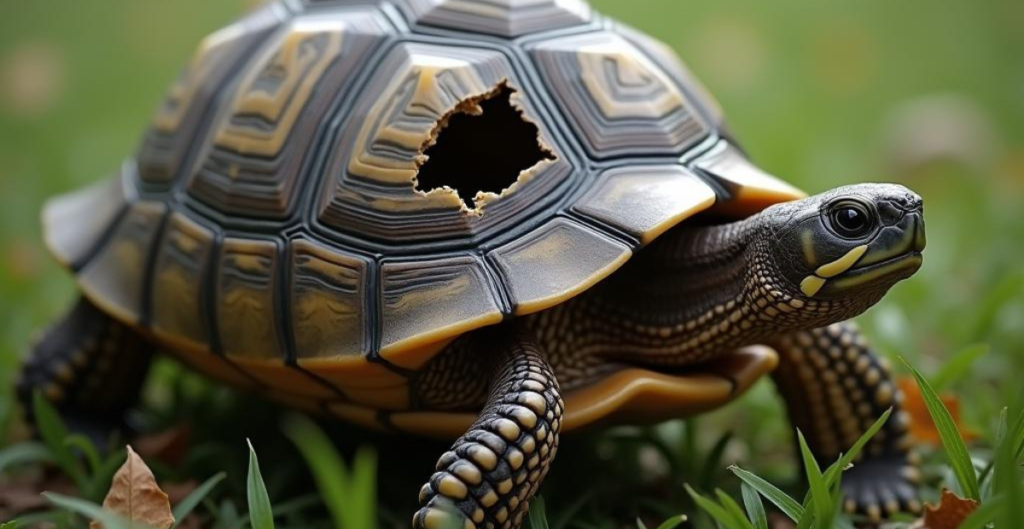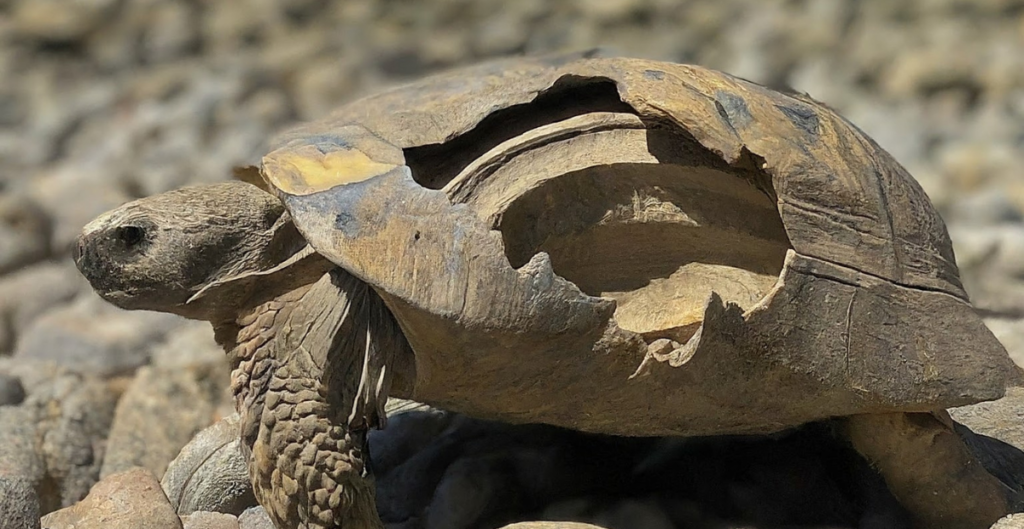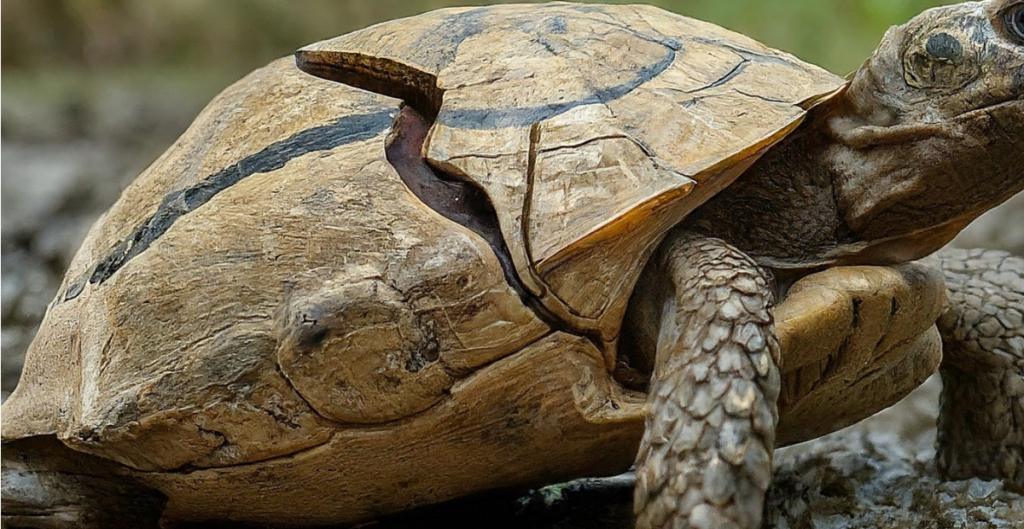Among many reptiles, turtles’ body structure is quite unique, which is its shell. Almost all turtle species have shells. The turtle’s shell is an integral part of their anatomy, which provides protection and support to them. Like any other part, a turtle shell can get injured or lost. Some reptiles can regenerate their organ. Keeping that in mind, some people wonder “can turtles regrow their under shells” or “if the complete layer of shells is”.
While turtles cannot fully regrow a lost shell, they can repair minor damages over time. This process involves the shedding of old scutes and the growth of new keratin layers. Shell health largely depends on factors like age, overall health, and especially a nutritious diet rich in calcium. Here, we will dig into this query about turtle shell regrowth or regeneration and the difference between regeneration and healing.
Can Turtles Regrow Under Their Shells?

No, turtle shells can not regrow or regenerate if lost completely. If a part of the shell structure is totally gone, then there is no chance this shell part will regenerate. Turtles can regrow their upper layer of shell with scutes
The process of shell healing in turtles involves gradual healing if it is not lost. If a turtle’s shell gets cracked or chipped, the top layer might peel off, allowing new layers to grow underneath. This process doesn’t replace the whole shell but covers minor injuries. For instance, a small crack caused by a fall may gradually seal as the turtle sheds and regrows its scutes.
Turtle Shell Regrowth vs. Healing

Is turtle shell regrowth and healing the same thing? No, it’s not. Let’s see why:
Limitations and Realities of Shell Regrowth
Turtle shells don’t regenerate completely. If a part of the shell is entirely gone, it won’t grow back like a lizard’s tail. This limitation means that any destroyed part of the shell can not grow back. The shell’s structure, composed of bone and keratin, can only undergo a layer of regrowth in the existing shell.
Shell Healing: Recovery from Injuries
Healing is different from regrowth. It involves the shell recovering from injuries like chips, fractures, or cracks. This process is gradual, similar to how bones heal over time. When a turtle’s shell is damaged, the bone underneath heals first. Osteoblasts are responsible for bone formation. They help create new bone structures, repairing fractures over time.
Role of Fibroblasts in Scute Regeneration
In addition to bone healing, fibroblasts contribute to scute regeneration. Scutes are the hard, keratin-covered sections of the shell. These cells produce connective tissue, which forms new scutes to replace the damaged ones. The turtle’s shell regains its strength because of this slow regeneration process.
What Are The Factors Affecting Turtle Shell Healing?
Several factors influence a turtle’s ability to repair its shell. For example, age is crucial; younger turtles often heal faster due to their rapid growth cycles. Health also plays a significant role; a turtle with a robust immune system has a better chance of recovering from shell injuries.
Additionally, the turtle’s habitat environment is vital. Turtles kept in clean, safe habitats with ample sunlight tend to heal more effectively. Sunlight provides essential UVB rays that help synthesize vitamin D3, which is crucial for calcium absorption.
What Are Causes of Severe Turtle Shell Damage

Here are some of the potential causes of turtle shell damage.
Pet Attacks at Home
Many turtle owners report that their pets, especially dogs, can pose a threat to turtle shells. Dogs may treat turtles as toys, leading to bites or scratches that can cause severe shell injuries. Keeping your turtle’s enclosure secure and supervising interactions with pets can prevent these incidents.
Car Accidents
Turtles often face shell damage due to car accidents. Statistics indicate that many turtles are involved in road-related incidents annually. For example, in certain areas, hundreds of turtles are admitted to wildlife hospitals each year due to vehicle collisions.
Environmental/Nature’s Challenges
The environment, such as harsh weather and natural disasters, can also damage turtle shells. During strong winds or floods, turtles can get pushed around and hit hard surfaces, which can damage their shells. Additionally, habitat destruction due to human activities reduces safe spaces for turtles, increasing their risk of injury.
Natural Predators: The Wild’s Risk
In the wild, turtles face threats from natural predators like raccoons and birds. These animals may attack turtles, aiming to breach their shells for food. Young turtles with softer shells are particularly vulnerable. Providing a safe and secure habitat can help protect turtles from these natural threats.
How To Avoid Turtle Shell Disease?
If you want to keep your turtle shell healthy, you have to ensure the right habitat environment and provide extra care.
Maintaining a Clean Habitat
Your turtle’s shell needs a clean habitat to stay in good condition. Regular cleaning prevents shell infections and keeps the turtle’s environment safe and hygienic. If the place is dirty and fungus grows, fungal infections will also affect the turtle shell.
Balanced Diet
Turtles require a balanced diet for strong shells. Without calcium-rich foods, their shells become fragile and crack. You should include plenty of leafy greens, protein, and calcium supplements to support shell strength.
Proper Lighting Setup
Turtles need proper lighting to stay healthy. Without enough UVB light, they can’t make vitamin D3, which is essential for absorbing calcium. A lack of calcium weakens their shells, which makes them prone to damage.
Regular Health Check-Ups
Just like any pet, turtle shell health requires regular check-ups. These visits to the vet are crucial for monitoring the condition of your turtle’s shell, allowing you to catch any potential issues early. If you keep track of your turtle’s health, you can keep their shell solid and healthy.
Avoiding Pet Attacks and Outdoor Accidents
When caring for your turtle, it’s essential to protect them from potential threats, such as attacks from other pets like dogs. Many turtle owners have shared experiences of their dogs causing injuries or even breaks to their turtle’s shells.
When taking your turtle outside, always supervise them closely to prevent accidents. Statistically, car accidents are a significant threat to wild turtles. Some reports indicate that an average of 374 turtles were killed on a North Florida highway in one year.
Case Studies and Observations on Turtle Shell Damage & Recovery
Turtles can face shell damage from various incidents, such as dog bites or accidents. For instance, surgical hardware repair has helped many turtles with shell fractures to recover. The average healing time for such maintenance is about 8 weeks.
Examples of Shell Damage and Recovery
According to our research, many turtles have suffered from dog bites. These injuries can be severe, but many turtles regain shell health with proper care and veterinary intervention. Another common scenario involves turtles involved in vehicle accidents. In one study, we found that 36 out of 51 turtles successfully healed from shell fractures because of timely medical care.
Visual Documentation and Expert Observations
Visual documentation plays a crucial role in understanding the healing process. Many photos and expert observations show how new layers of keratin form under damaged areas, replacing dead bone. Veterinarians and caregivers can monitor progress and adjust treatments based on this.
Limitations and Challenges
However, not all shell damage leads to full recovery. In some severe cases, regrowth may be limited or impossible. This can happen if the damage penetrates too deeply into the shell structure. In the long run, severe damage can lead to permanent structural changes or vulnerabilities in the shell.
FAQs
Can turtle shells grow back?
No, turtle shells cannot grow back if severely destroyed or lost. However, minor injuries can heal over time with proper care.
Will turtle shells repair themselves?
Yes, turtle shells can repair themselves from small chips or cracks if the turtle has a healthy environment and good nutrition.
Do turtles shed their shells?
No, turtles do not shed their shells. The shell is a part of their body and grows with them, similar to how bones grow in humans. They shed the outer layers of their shells, known as scutes, as they grow.
Finally
The answer to the question ‘Can turtles regrow their under shells?’ or ‘Can a turtle’s shell regenerate?’ is no. Turtles cannot regrow their undershells once severely damaged or lost. However, they can heal from minor injuries such as chips or fractures with proper care and attention. They need a suitable habitat, a balanced diet, and clean living conditions to heal.
